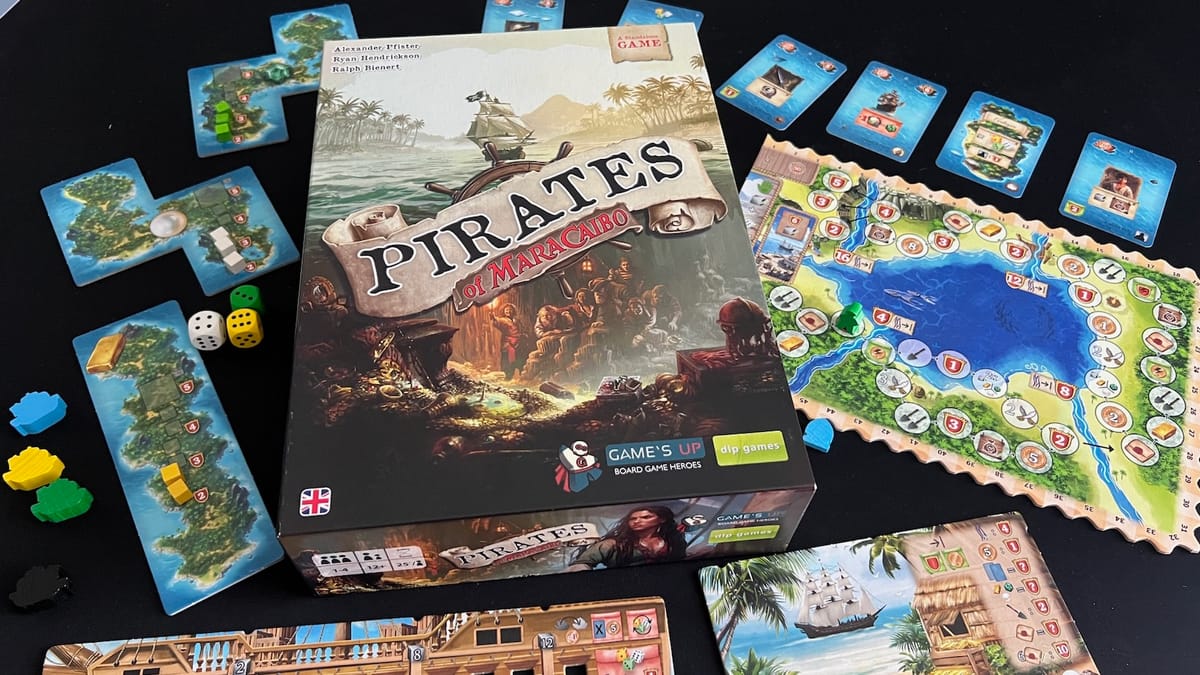
Back in 2019, Alexander Pfister released Maracaibo to the board gaming world. When I started into the tabletop hobby, I was coming off of a year spent on the island of Jamaica and was basically sailing every weekend. Maracaibo and other sailing games were instant additions to the collection. Maracaibo, while frustrating at times, was one of my first introductions into deeper strategy and I spent a lot of time working my way through the campaign with my wife. When I heard that Pirates of Maracaibo was releasing, my first thought was a watered down version of the original, but I was pleasantly surprised and may have found my new favorite sea game.
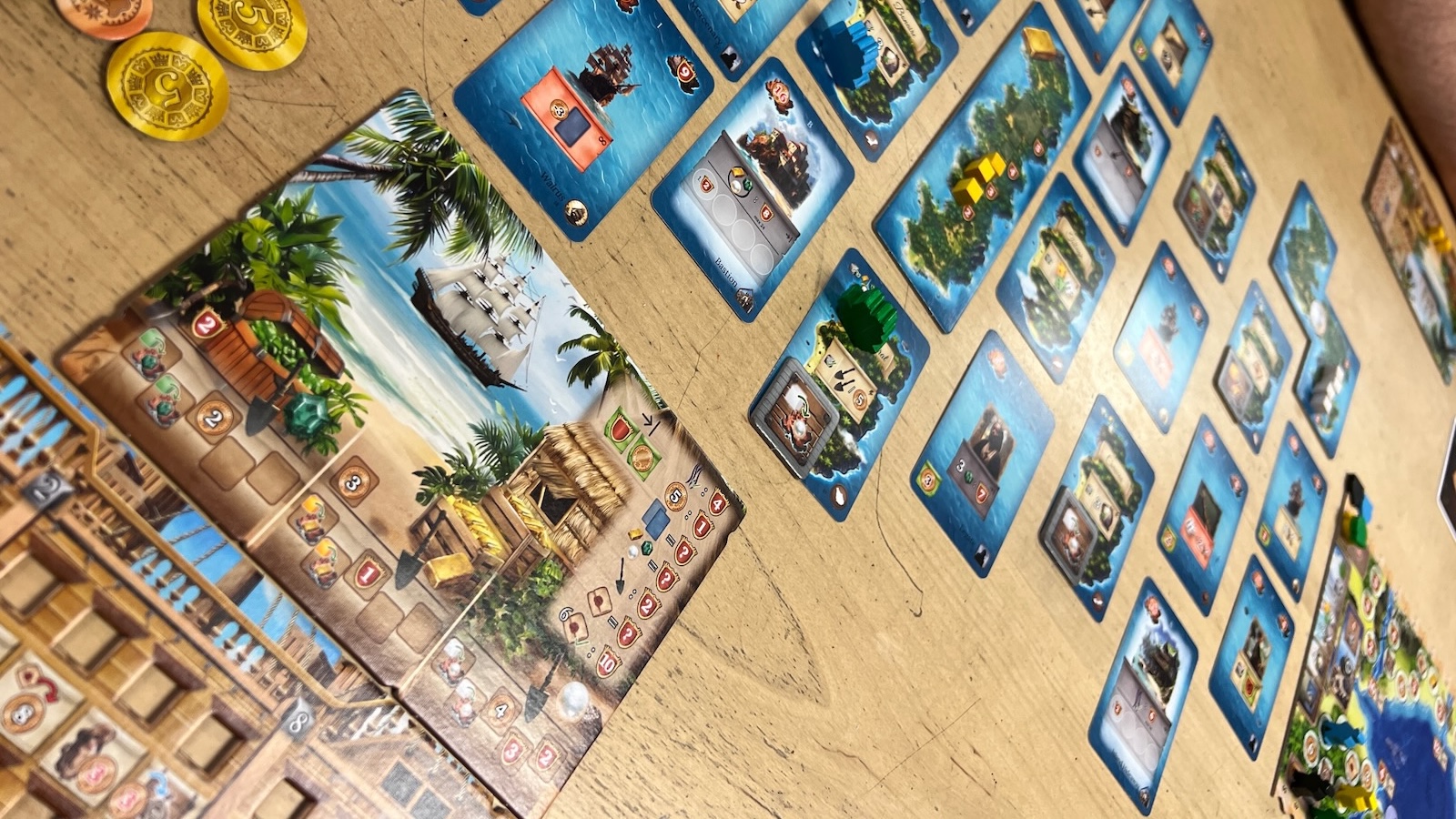
Released in 2023 to the European market through publisher dlp games and slated for a 2024 GenCon release in the states through Capstone Games with and updated rulebook, Pirates of Maracaibo is a sailing themed game designed by Alexander Pfister, Ryan Hendrickson, and Ralph Bienert. In Pirates, 1-4 players will sail towards the city of Maracaibo upgrading their ship, collecting new vessels for their fleet, hiring crew, collecting goods, and hoarding treasure, all in hopes of gaining enough points by the end of three rounds to be labeled the toughest pirate on the seas.
The main board of the game consists of various different cards with large island boards intersecting parts of the ocean. Each of these cards represents spaces that ships can sail to and interact with and come in a variety of styles.
- Improvement Cards: Denoted by different symbols in the bottom corner, equipment, crew, and ship cards offer one-time, ongoing, or end of game bonuses to the player who acquires them. All improvement cards can be attained by paying a cost and may also award end game points or income for later in the game.
- Residence Cards: These high cost cards allow players to place a marker on them giving big end game scoring bonuses.
- Location Cards: These cards represent different locations in the Caribbean that pirates can stop at to upgrade their ship, may contain black markets, and offer different actions to players. Some locations may also add stock to one of three main treasures in the game.
As cards are acquired throughout the game, new cards will be added. Each of the large islands in the main game area represents the market for the three treasures: pearls, gold, and emeralds. The number of cubes on these islands represents the worth of each type of treasure at the end of the game and the current stock that players can gain treasure from. The final board holds the scoring track and the exploration track that offers bonuses as players move along the jungle trail.
Gameplay Overview
Players will begin their turn by moving their ship token 1-3 spaces along the ocean of cards. Players can move to any adjoining card, but have to advance at least one column by the end of their turn. Players cannot move backwards. Players will then interact with the card they land on, often triggering actions. There are a few main actions triggered by cards:
Raiding

Players roll a set of three dice, with one reroll allowed if the dice aren’t what they want, and choose one to execute the action. Each die represents one of the three treasure types. Players may then spend their raiding value from the dice, and any ongoing bonuses, from the menu of options printed on their ship board or unlocked from acquired upgrades and cards. This often includes gaining treasure matching the die they chose, doubloons, or victory points.
Explore

As players explore, they move along the jungle, triggering an action on the space they land on. Many ongoing effects will add exploration movement. Players can gain other actions, money, treasure, and victory points along the trail. The path features four rivers, and if the players can cross all four, they will get 16 points at the end of the game.
Bury Treasure

As players acquire treasure cubes, they are placed on the hideout board, above ground. As players bury the treasure, they become more valuable at the end of the game. Each buried treasure can also unlock bonuses that add more cubes to the market or other bonuses such as points and money.
Gain Quests
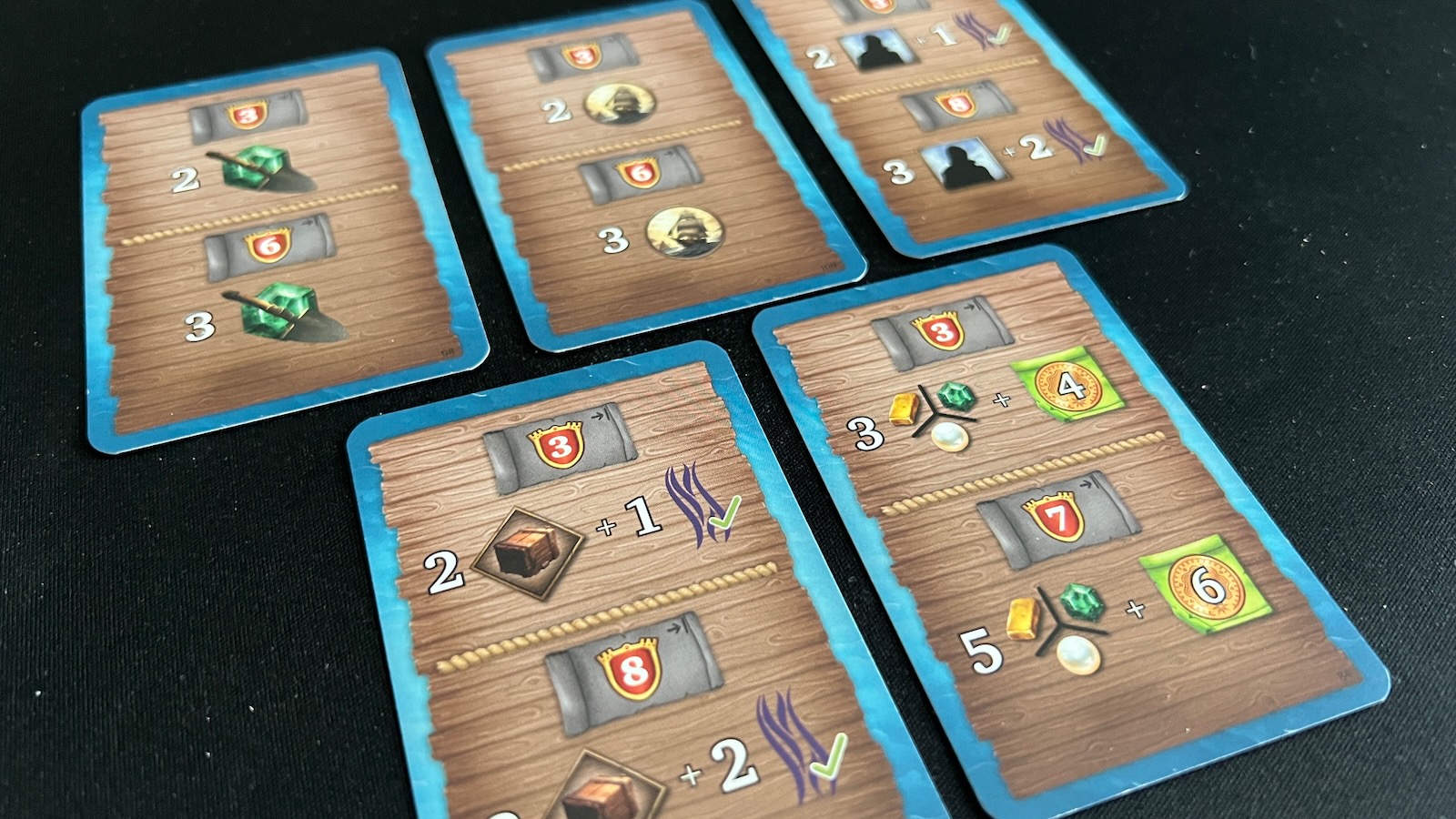
Players can draw quest cards throughout the game that award points if players can achieve certain milestones. Each quest offers two different rewards with the higher reward being harder to achieve.
Upgrading Ship
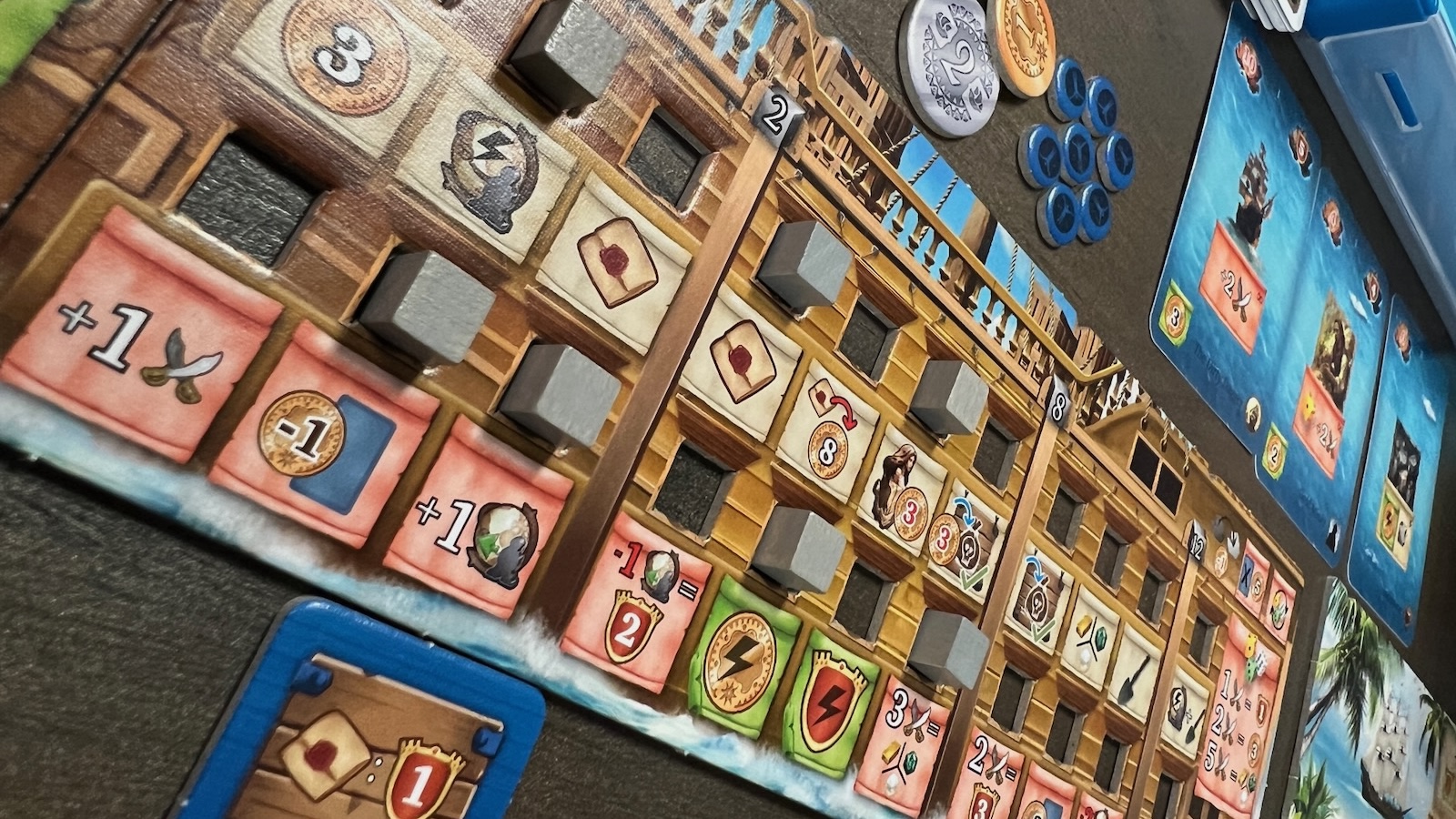
Ship upgrades unlock one time and ongoing abilities for the players. As more cubes are placed, new sections of upgrades are unlocked for the players to use. Some unique upgrades allow players to buy a figurehead for their ship and place black market tiles for their ships to visit for bonuses in the game.
The first player to reach Maracaibo triggers the end of the round and will be rewarded with 6 victory points and a ship upgrade. All players will receive income from green banners on their acquired cards in the form of money and victory points. Then all ships will be returned to the start of the ocean and play will resume with the next player’s turn. After three rounds, players will finish the player rotation so all players get the same amount of turns. Players will then score end game points to determine the final score.
Modules and Solo Mode
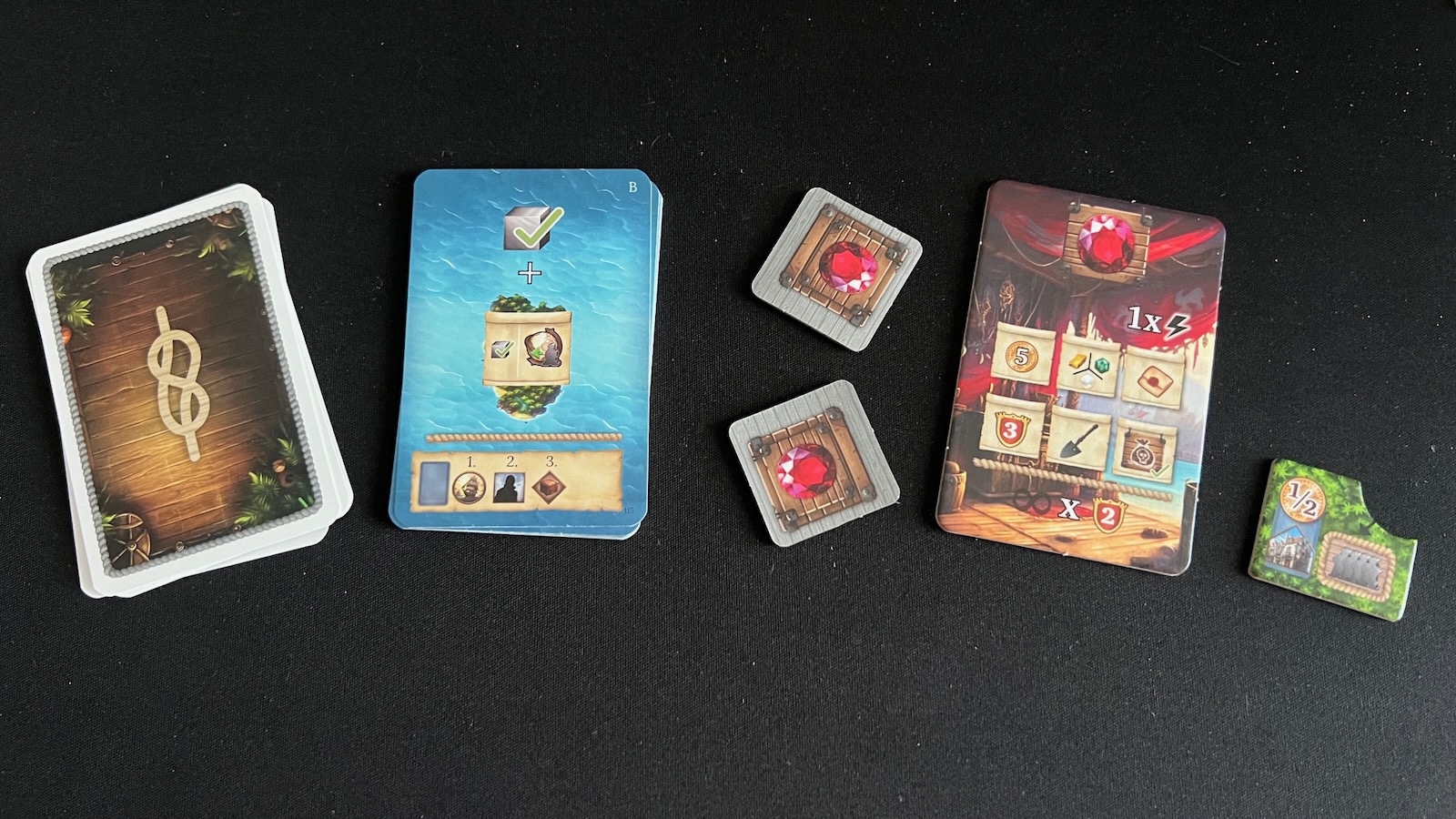
The game comes with alternate rules for solo play and some multiplayer modules you can include with your games. Apart from the solo mode, all of these modules add some fun new challenges to your game and all have and will be integrated into every game on my table.
Solo Mode – Jordan the Pirate
In the solo mode, one player will compete against Jordan, who is controlled by a deck of cards. Jordan will never pay or gain money throughout the game. Jordan also has a special solo hideout board that features a Raiding & Explore track. On their turn, Jordan will flip a card from the deck that depicts a variety of actions. Jordan will move to a card featuring the action that is within 3 movement spaces. The rulebook outlines the small nuances Jordan will take when selecting and performing the various actions in the game, but Jordan will play very similar to a human player. The player will work through their turns in the same way as the multiplayer game. At the end of a solo game, the player with the highest score will win. Each of the modules listed below also come with rules on how to integrate them into the solo gameplay.
Fog of War
Exploring the ocean for the first time means there is a lot to discover. The Fog of War modules allow players to add some mystery into the game by masking Locations and/or Improvement cards added to the game. When the initial location cards are added to the set-up deck, they are added face down. As players move throughout the game, they flip the cards when reaching a location. The other modification players can add to the set-up is taking half of the Tier II deck and flipping them the opposite direction. When players remove cards from the map and draw to replace, some cards will be right side up and some will be face down.
Pirate Skirmish
This module affects gameplay when players end their movement on the same space as another pirate ship. This allows players to face off in a raiding die roll. The player with the higher roll plus their permanent raiding value will gain 2 points and steal up to 1 doubloon from the other player.
Quest Hunters
Allows players to draw three and keep two quests at the start of the game.
Rubies
This adds a fourth gem market to the game. Special tiles are added to Bonaire and Tabago during set-up and a ruby market board is added to the game. Players gain rubies by visiting the two special locations and may sell one ruby when they reach the gulf space. Players will take the cube and cover up one of the bonuses on the ruby board and any left over rubies are worth 2 points at the end of the game.
Retirement
A special tile is added to the exploration track along with one marker from each active player. If a player decides to move to this tile, their explorer has retired and they may put their marker on any residence card for half price. Explorers are then sent back to the start of the exploration track. As a bonus, the tile can also be used in the original game of Maracaibo, allowing players to halve the price of a Prestige Building.
Components and Production Thoughts

The components of the game are fairly straightforward, utilizing design choices from the previous iteration of Maracaibo. The iconography and coloring of the game mirror how they are used in Maracaibo making it easier to pick this game up if you have played the original. Some of the newer players had difficulty with the iconography at the beginning of the game, but were able to pick it up fairly quickly. The artwork used throughout and the color palette of the cards makes it feel like you are sailing through the ocean, inviting you into the feeling of the ocean and the spray of the saltwater. The design on the rulebook makes the game quick to teach and easy to find the rules you may be referencing with the iconography. Placing the symbol appendix at the back of the book makes for easy reference when trying to locate the specific actions listed on a card or your ship. The player boards and ships are made of a similar thickness of cardboard as previous games from this developer, but the cutouts on the ships make it easy to hold the upgrade cubes. The puzzle piece addition of the figureheads was a nice touch as well.
Gameplay Thoughts
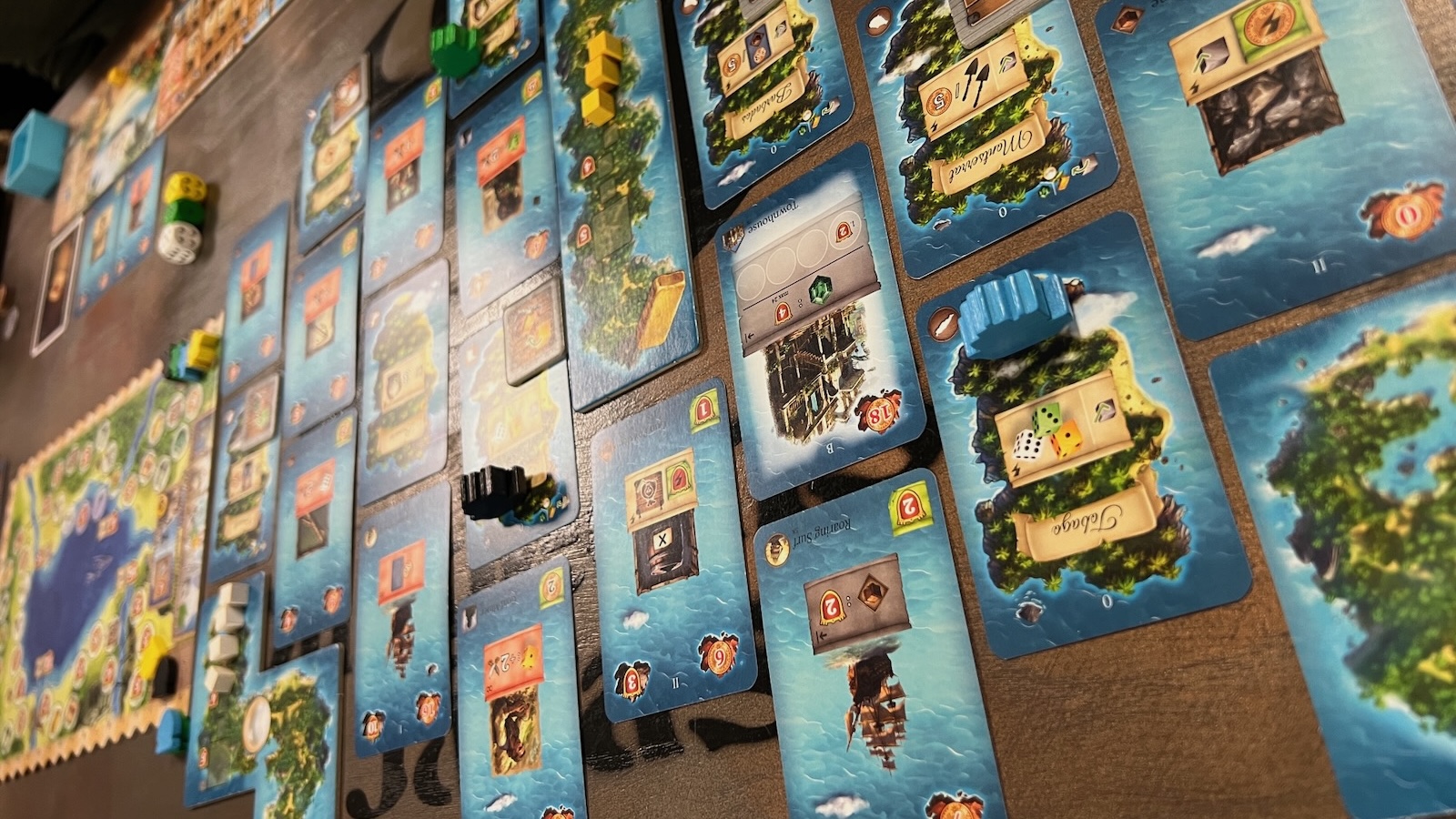
Pirates of Maracaibo has officially surpassed the original in my mind. This iteration is visually more appealing and plays smoother than the original. Movement, though similar in the forward direction, is much more freeform, allowing players to move towards islands that are tailored to their game strategy. Having the main play area made up of cards allows for alternate set-ups and a lot more flexibility in gameplay. The randomness of the set-up and how cards are placed in the game makes replayability for this game very high. The constant acquiring and replacing of cards in the main play area requires players to adapt to ever changing gamestate. Multiple times I heard players lamenting the loss of cards they were planning on purchasing on their next turn and having to pivot. One of the best additions to this version of the game are the treasure markets. As players acquire treasure, the value drops, but players have the ability to add treasure back to the market to try and increase their end game points. Just like in the regular stock market, diversification of treasure seems to be the hot strategy, but sometimes the roll of the dice or the treasure for a specific action card doesn’t suit your needs. The explore track is another similar element from the original game, but it seems to allow players to benefit more in Pirates through end game scoring goals and river crossing bonuses. Without an included campaign element, Pirates of Maracaibo also makes it easier for players to get a game to the table without having to adjust the board state.
The only detractor I had to the gameplay of this game is the rondel style movement of the rounds. If someone wants to rush their way to Maracaibo, they won’t get to upgrade their engine too much but this decision will dictate the moves of the rest of the players. A hallmark of other Pfister games such as Great Western Trail, Boon Lake, and Maracaibo, I’ve never been a big fan of the race to the end of the round mechanic. While players will often get another turn when the end of round/game is triggered, sometimes you are unable to finish your tasks. Of course, this hasn’t stopped me from playing the above mentioned games many many times in the past. My only other fun addition to the game would have been more player interaction when the pirate ships met. It would have been fun to up the combat a bit and maybe included an element of stealing equipment, crew, and ships. At least you get a little something when you meet your foes on the water.
Pirates of Maracaibo
Excellent
Pirates of Maracaibo is a great entry into the Pfister family of games and seems a lot more accessible for the casual gamer while also adding in a fair bit of brain burning strategy. This is one that will be in heavy rotation on my table and I can’t wait to get this ship back on the open water.
Pros
- Great visuals and aesthetics lending to the theme
- Clear iconography and a clear appendix for questions
- Easier entry into strategy games than some of creators other games
Cons
- Someone else's decisions can dictate length of game
- Need more pirate to pirate interaction incentives
